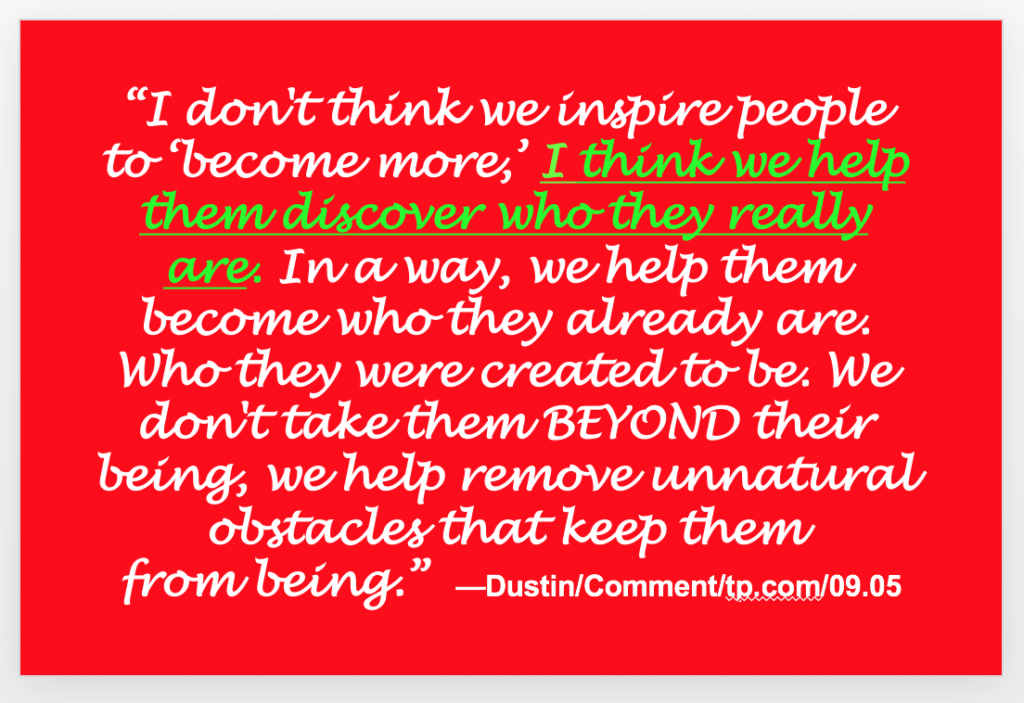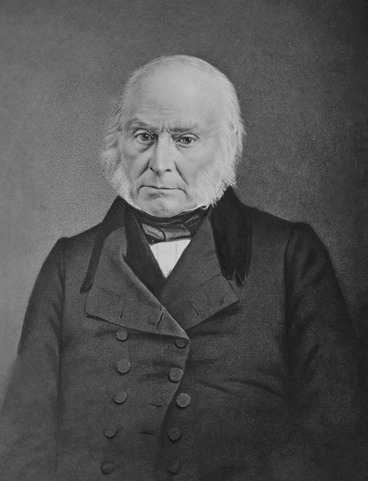There are few figures who have addressed the topic of leadership with the zeal of Tom Peters. Years ago, I participated in an online community of folks on Tom Peters’ website. One day, Tom posted this quote.
“If your actions inspire others to dream more, learn more, do more and become more, you are a leader.”
—John Quincy Adams
The statement is a wonderful encouragement to define leadership as an act of inspiration and transformation. But, as I thought more about it, I began to wonder if it was a bit misleading. Who am I to argue with dead presidents? Still, since I believe in the inherent potential residing in each of us, I wrote:
“I don’t think we inspire people to ‘become more,’ I think we help them discover who they really are. In a way, we help them become who they already are. Who they were created to be. We don’t take them BEYOND their being, we help remove unnatural obstacles that keep them from being.”
To my wondrous surprise, Tom Peters took my comment and used it as a part of his presentation on “The Nub of Leadership.”

I am not bringing this up so I can brag about it. It’s a blog comment from over 10 years ago, and I don’t want to come across like Napoleon Dynamite’s Uncle Rico reliving his “glory days.” I mention this because have been thinking recently about why this resonated with someone as wise and prolific as Tom Peters. I’ve also been considering why I felt strongly enough to make the comment in the first place. Here are some conclusions:
- I wholeheartedly believe the untapped potential of our people is the greatest resource available to improve our workplaces and organizations today.
- I also believe there are a myriad of obstacles that limit that potential–unnecessarily.
If both these statements bear out, then one of the most important things we can do as leaders is to manage the barriers that limit our people. It would then make sense that Tom Peters included this in his presentation The Nub of Leadership: Helping/Inviting Others to “Discover Their Greatness.”
But, how do you manage barriers so people are allowed to discover and explore their greatness? I haven’t seen much about this in business books and writing, so I decided to cover six leadership styles based on different ways to manage barriers. As you read these, think about which style you use and the kind of leaders with whom you work best.
- Drill Sergeant
Overcoming these barriers will make you stronger. Yes, it would be faster if that wall wasn’t there, but you’ll develop new muscles by pulling yourself up that rope to the top and climbing over. If you complain, procrastinate or try to go around – I will push you and force you to struggle through the challenge. This may seem harsh, but–in the end–I’m making you better. - Cheerleader
You can do it! I believe in you. By reminding you of how incredible you are, I inspire you to overcome whatever is in your path. It doesn’t matter what it is, you have the ability, deep inside yourself, to rise above. If you don’t succeed, maybe you didn’t believe in yourself. In that case, I’ll give you an extra dose of confidence through my never-ending encouragement. Go for it!! - The Pessimist
Sometimes, it isn’t worth risking failure in order to overcome obstacles. There may be a good reason that road block is there. Play it safe. We don’t want anyone getting hurt or losing lots of money just because they thought they could succeed against the odds. Remember, it’s the tallest blade of grass that gets cut. So, don’t try to grow too fast. Just stick to the status quo. - The Circumventer
There’s always another way of doing things. You don’t have to go over the top, we can go around instead. Sure, it might take longer… a lot longer… but it reduces the level of effort needed in the short run. I’m not looking to invest, we need to bootstrap our operations. Learn to do more with less and look for opportunities to “zig” when others “zag.” - The Micromanager
I know how I would overcome these barriers and I will give you each step to take. I don’t just want you to succeed, I want you to do it the right way. You may have your own ideas, but set those aside for now and trust me. I feel much better when I know things are under control and proceeding as planned, so report back to me often and give me the opportunity to redirect you as needed. - The Barrier Breaker
If that barrier is unnecessary, then let’s get rid of it. I’ll run the traps for you. Let’s cut the red tape and take the weights off your legs. I want you freed up to take on the important work. Realize I can’t break all the barriers for you. There are some you do need to work through in order to learn and grow. But there are lots of obstacles that serve no purpose and I’m going to get those out of your way so you can reach your full potential.
Although it may appear being a “Barrier Breaker” is ideal, it may be best to apply situational leadership to these styles. Each may be suited for a specific situation. Yes, even “The Micromanager.” As folks are learning a new job or are early in their careers, they may need micromanagement until they gain understanding and can make greater contributions.
What do you think? Is this important to you? Do you have other thoughts or observations?

